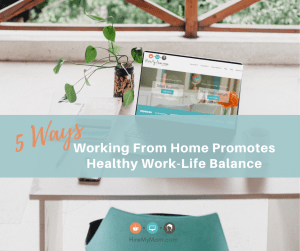How to Improve Your Health and Fitness While You Make Money From Home

As a new year dawns, many people set health and fitness goals. It’s certainly a popular theme around our virtual water cooler, and we bet it’s trending in your life, too.
You know the basic advice–make health and fitness a priority, move more, sleep better, plan meals. But, working at home throws up some challenges to even the best-laid health and fitness plans.
With years of collective experience working at home and working to stay fit, we’ve put our heads together to share our best tips for success. In each category, we include our favorite small changes that make health and fitness success easier from a home office and build up to more significant changes that have helped us find success on our fitness journeys.
It’s easy to let caring for yourself slide down the priority list as you manage home and work concerns. Sometimes slipping 15 minutes of extra work into your day instead of doing something for your wellbeing is the difference between meeting a deadline or missing it. We get that. But, we also know that ignoring your health can backfire, which is why it’s critical to make it a priority. We hope these tips help you on your journey.
Move more
Working at home offers many advantages, including the 10-second commute, the flexibility to address family issues, and the ability to work comfortably in casual clothes. But, it also offers challenges, like easy access to a kitchen and fewer reasons to go outside or move much.
At home, it’s easy to avoid the type of incidental movement that happens organically when you work in an office. For example, you don’t have to walk in from the parking lot or train station. You never need to stroll down the hall to see a coworker or dash across town for a meeting. In addition, popping outside for a quick walk is more difficult if you have a sleeping baby or a young child who needs you nearby.
Scheduling a workout as part of most days is the surest way to prioritize exercise. We understand this doesn’t always work–and can be a little demoralizing if you miss a workout. But, it’s still essential to move. Here are some of our tips for quickly adding movement to your day:
- Prop your computer up so you can stand for a portion of your workday. Standing while responding to email or doing light reading can help you feel more powerful and in control of your time.
- Walk around your house while chatting on the phone. You’ll be surprised how many laps you can take around your home office during a 10-minute chat. Bonus: You won’t be tempted to multi-task by checking emails or sneaking a peek at your favorite website.
- Set a timer to remind you to get up each hour. When the timer goes off, walk around or stretch for five minutes.
- Learn two yoga poses you can do in your home office space. Do one when you start working and one when you stop working. If you work in spurts throughout the day, this light approach to exercise can pay off while helping you get more focused.
- Keep light dumbbells next to your desk. Pick them up for some curls or chest presses when your hands are free.
- Do 20 jumping jacks between tasks. You’ll get your blood flowing, switch tasks more quickly and find that your focus is better when you return to work.
- Start and end your workday by doing planks. Use the time to transition from mom mode to work mode.
- Use your office wall to do standing push-ups.
- Sprint up and down your stairs a few times between calls or projects.
When you finish work, scoop up your kids and head outside for fresh air and fun. Even if it’s not a full-on workout, a little light movement with your kids can help you transition back into family mode and give everyone a chance to reset and destress from a busy day.
Plan your meals and snacks
Working at home means unfettered access to your kitchen. This can be a great money saver because you can always brew your coffee and make your lunch. But, it can also lead to mindless snacking and stress eating. Paradoxically, we sometimes find ourselves skipping lunch because we are really in the flow of work. This sets the stage for heavy (and often unplanned) afternoon snacking, sabotaging health and fitness goals.
Here are our best tips to avoid the pitfalls of having such easy access to all of your groceries all of the time.
- Make a list of healthy snacks and meals that you find satisfying and have them on hand. We like pre-portioned items because they are easy to grab and having a pre-portioned amount makes it easier to control your portion size.
- Pack your lunch and snacks the night before so you don’t have to make eating decisions during the heat of the business day.
- Take a planned lunch break, especially if you work a full day. Leave your home office to avoid eating at your desk during your lunch break and multi-tasking through your break. You’ll enjoy your lunch more and will feel more refreshed. Bonus if you do a few exercises at the start and stop of each work period, as you’ll add two workout segments to your day.
Also, we have found that it’s essential to have a meal game plan at the start of each week to avoid a scramble for an evening meal. Apps, meal planning services, and grocery delivery can help you work smarter, not harder, in the kitchen and make it easier to achieve your fitness goals. Check out these tips to help ease family meal planning.
Finally, let’s talk about how the food needs of other family members can derail your plans for healthy eating. If your kids are like ours, you likely frequently answer questions about what’s for dinner and what snacks are available. Stops and starts to field snack inquiries can distract from your work and make you hungry.
We’ve found that creating a weekly menu that covers all meals and snacks and hanging it on the refrigerator helps make this easier.
Direct your children to the menu when hunger strikes. (Make sure that some of the snacks can easily be grabbed and opened by young kids. For really young kids, include pictures of items they can select and make them easy to reach.) Having a posted menu reduces the discussion around what’s available to eat, eliminating a distraction for you as you work. Frankly, this one action will buy you untold peace of mind, help you reclaim time every day and make it easier not to snack every time a kid asks for one.
Maintain a good sleep schedule
We often advise rising early or burning the midnight oil to squeeze extra work into the day, reduce child care expenses and make the most of your days. However, that advice comes with an asterisk that you are still getting the sleep you need to be productive. Sure, it’s possible to rise before dawn or stay up well past your bedtime occasionally. However, making a habit out of it will leave you feeling depleted and tired. Here are some of the ways we make sure to get enough sleep:
- Set a bedtime for yourself and stick to it. If you know you need to get up at 6 to add some work time to your day, be sure to count back and make sure you get to bed early enough to get enough sleep.
- Maintain a consistent sleep schedule. Try to go to sleep and wake up around the same time most days. This will help you feel better and make deviations easier when they do happen.
- Turn off all screens an hour before bedtime. Transitioning to a book or other non-screen activity makes it easier to fall asleep.
Please share!
Please tell us what tricks work for you! How have you found success working from home while focusing on health and fitness?









